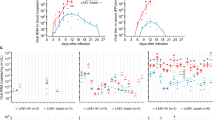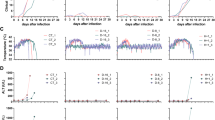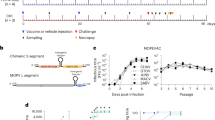Abstract
There are no approved treatments for Lassa fever, which is endemic to the same regions of West Africa that were recently devastated by Ebola. Here we show that a combination of human monoclonal antibodies that cross-react with the glycoproteins of all four clades of Lassa virus is able to rescue 100% of cynomolgus macaques when treatment is initiated at advanced stages of disease, including up to 8 d after challenge.
This is a preview of subscription content, access via your institution
Access options
Access Nature and 54 other Nature Portfolio journals
Get Nature+, our best-value online-access subscription
$32.99 / 30 days
cancel any time
Subscribe to this journal
Receive 12 print issues and online access
$259.00 per year
only $21.58 per issue
Buy this article
- Purchase on SpringerLink
- Instant access to full article PDF
Prices may be subject to local taxes which are calculated during checkout


Similar content being viewed by others
References
McCormick, J.B., Webb, P.A., Krebs, J.W., Johnson, K.M. & Smith, E.S. J. Infect. Dis. 155, 437–444 (1987).
Shaffer, J.G. et al. PLoS Negl. Trop. Dis. 8, e2748 (2014).
World Health Organization. Lassa Fever – Nigeria. Available at: http://www.who.int/csr/don/28-june-2017-lassa-fever-nigeria/en/. (Accessed 5 July 2017).
Schmitz, H. et al. Microbes Infect. 4, 43–50 (2002).
Amorosa, V. et al. Emerg. Infect. Dis. 16, 1598–1600 (2010).
Fisher-Hoch, S.P., Hutwagner, L., Brown, B. & McCormick, J.B. J. Virol. 74, 6777–6783 (2000).
Geisbert, T.W. et al. PLoS Med. 2, e183 (2005).
Jahrling, P.B. et al. J. Infect. Dis. 141, 580–589 (1980).
Jahrling, P.B., Peters, C.J. & Stephen, E.L. J. Infect. Dis. 149, 420–427 (1984).
Jahrling, P.B. & Peters, C.J. Infect. Immun. 44, 528–533 (1984).
McCormick, J.B. et al. N. Engl. J. Med. 314, 20–26 (1986).
Leifer, E., Gocke, D.J. & Bourne, H. Am. J. Trop. Med. Hyg. 19, 677–679 (1970).
Emond, R.T., Bannister, B., Lloyd, G., Southee, T.J. & Bowen, E.T. Br. Med. J. 285, 1001–1002 (1982).
Frame, J.D., Verbrugge, G.P., Gill, R.G. & Pinneo, L. Trans. R. Soc. Trop. Med. Hyg. 78, 319–324 (1984).
Cao, W. et al. Science 282, 2079–2081 (1998).
Robinson, J.E. et al. Nat. Commun. 7, 11544 (2016).
Cross, R.W. et al. Antiviral Res. 133, 218–222 (2016).
Thi, E.P. et al. Nature 521, 362–365 (2015).
Thi, E.P. et al. Sci. Transl. Med. 6, 250ra116 (2014).
Grove, J.N. et al. Virol. J. 8, 314–314 (2011).
Acknowledgements
The authors thank K. Schuenke (UTMB) for administrative assistance; N. Dobias (UTMB) and the University of Texas Medical Branch (UTMB) Research Histology Core for assistance with tissue preparations; and C. Klages, J. Graber, and the UTMB Animal Resource Center for veterinary and husbandry support. The authors also thank all the members of the Viral Hemorrhagic Fever Consortium for their continued support and contributions to the VHF field (http://www.vhfc.org). In memoriam: Tragically, two co-authors, who contributed greatly to public-health and VHF research efforts in Sierra Leone, contracted Ebola hemorrhagic fever and lost their battle with the disease before this manuscript could be published: Mohamed Fullah and Sheik Humarr Khan. We wish to honor their memory. This work was supported by the Department of Health and Human Services/National Institutes of Health/National Institute of Allergy and Infectious Diseases Challenge and Partnership Grant Numbers AI067188 (PI: R.F.G.) and AI082119 (PI: R.F.G.), Health and Human Services Contract HHSN272200900049C (PI: J.E.R.), and National Institutes of Health/National Institute of Allergy and Infectious Diseases grant number R01AI104621 (PI: R.F.G.), U19AI109762 (PI: E.O. Saphire), UC7AI094660 to UTMB for BSL-4 operations support of the Galveston National Laboratory, and RC-0013-07 (PI: R.F.G.) from the Louisiana Board of Regents.
Author information
Authors and Affiliations
Contributions
C.E.M., R.W.C., L.M.B, J.E.R., R.F.G., and T.W.G. conceived and designed the experiments. C.E.M., R.W.C., J.B.G., D.J.D., and T.W.G. performed the Lassa NHP challenge and treatment experiments and conducted clinical observations of the animals. J.B.G., K.N.A., and V.B. performed the clinical-pathology assays. J.B.G., R.W.C., and V.B. performed the LASV-infectivity assays. R.W.C. performed ELISA assays. C.E.M. and K.N.A. performed the PCR assays. C.E.M., R.W.C., L.M.B., J.B.G., V.B., K.N.A., D.J.D., M.M.R., M.L.H., A.G., M.M., D.S.G., K.A.F., J.E.R., R.F.G., and T.W.G. analyzed the data. K.A.F. performed histologic and immunohistochemical analysis of the data. M.L.B, A.G., M.M., M.F., R.W.C, L.M.B., and R.F.G. developed and validated LASV ELISA assays. S.H.K. and R.F.G managed the identification of convalescent LF patients and collected PBMCs for the derivation of huMAbs. J.E.R. and R.F.G. derived LASV huMAbs. C.E.M., R.W.C., L.M.B., R.F.G., and T.W.G. wrote the paper. All authors had access to all the data, and approved the final version of the manuscript.
Corresponding authors
Ethics declarations
Competing interests
L.M.B. and R.F.G. are co-founders of Zalgen Labs. L.M.B. receives compensation from Zalgen Labs. R.F.G. does not receive compensation from Zalgen Labs. M.L.H., M.M.R. and M.L.B. are employed by Zalgen Labs and receive compensation from the company. The other authors declare no competing interests. Opinions, interpretations, conclusions, and recommendations are those of the authors and are not necessarily endorsed by Tulane University or the University of Texas Medical Branch.
Supplementary information
Supplementary Text and Figures
Supplementary Tables 1–5 and Supplementary Figures 1–7 (PDF 2603 kb)
Rights and permissions
About this article
Cite this article
Mire, C., Cross, R., Geisbert, J. et al. Human-monoclonal-antibody therapy protects nonhuman primates against advanced Lassa fever. Nat Med 23, 1146–1149 (2017). https://doi.org/10.1038/nm.4396
Received:
Accepted:
Published:
Issue date:
DOI: https://doi.org/10.1038/nm.4396
This article is cited by
-
Lassa virus protein–protein interactions as mediators of Lassa fever pathogenesis
Virology Journal (2025)
-
Remdesivir, mAb114, REGN-EB3, and ZMapp partially rescue nonhuman primates infected with a low passage Kikwit variant of Ebola virus
Nature Communications (2025)
-
Oral obeldesivir provides postexposure protection against Marburg virus in nonhuman primates
Nature Medicine (2025)
-
Current perspectives on vaccines and therapeutics for Lassa Fever
Virology Journal (2024)
-
Inactivated rabies-based Lassa fever virus vaccine candidate LASSARAB protects nonhuman primates from lethal disease
npj Vaccines (2024)



